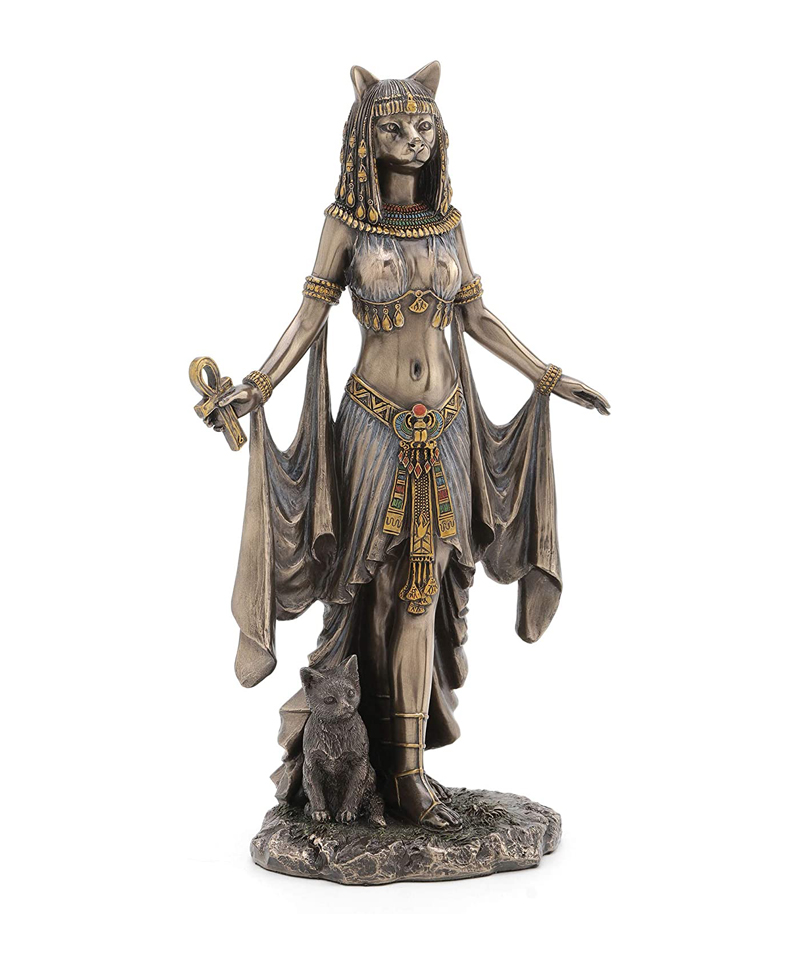Bastet “Egyptian Goddess of Protection” Statue
In this Egyptian Goddess Bastet Statue you can see Her older avenging lioness aspect ready to pounce at any moment. The paint job is phenomenal, the sculpt is amazing and captures so much of who Bastet was, is, and ever will be. There is movement to this. The statue captures that cross-footed balance that cats possess. It’s like the beginning of a ritual dance. Her arms and body positioning are strong and protective, evoking the four golden goddess statues protecting Tutankhamun‘s canopic shrine. But it’s the face sculpt to have an excellent feline likeness, of course. There is an anthropomorphic playfulness and wisdom here. Bastet or Bast was a goddess of Ancient Egyptian religion, worshiped as early as the Second Dynasty (2890 BCE). Her name also is rendered as B’sst, Baast, Ubaste, and Baset. In ancient Greek religion, she was known as Ailuros (Cat). Bastet was worshiped in Bubastis in Lower Egypt, originally as a lioness goddess, a role shared by other deities such as Sekhmet.
Eventually Bastet and Sekhmet were characterized as two aspects of the same goddess, with Sekhmet representing the powerful warrior and protector aspect and Bastet, who increasingly was depicted as a cat, representing a gentler aspect. What the name of the goddess means remains uncertain. Names of Ancient Egyptian deities often were represented as references to associations or with euphemisms, being cult secrets. One recent suggestion by Stephen Quirke (Ancient Egyptian Religion) explains Bastet as meaning, “She of the ointment jar“. This ties in with the observation that her name was written with the hieroglyph for ointment jar and that she was associated with protective ointments, among other things. The name of the material known as alabaster might, through Greek, come from the name of the goddess. This association would have come about much later than when the goddess was a protective lioness goddess, however, and is useful only in deciphering the origin of the term, Alabaster.
Bastet was originally a fierce lioness warrior goddess of the sun worshiped throughout most of Ancient Egyptian history, but later she became Bastet, the cat goddess that is familiar today. She then was depicted as the daughter of Ra and Isis, and the consort of Ptah, with whom she had a son Maahes. As protector of Lower Egypt, she was seen as defender of the king, and consequently of the sun god, Ra. Along with other deities such as Hathor, Sekhmet, and Isis, Bastet was associated with the Eye of Ra. She has been depicted as fighting the evil snake named Apep, an enemy of Ra. In addition to her solar connections, sometimes she was called “Eye of the Moon“. Bastet was also a goddess of pregnancy and childbirth, possibly because of the fertility of the domestic cat. Images of Bastet were often created from alabaster. The goddess was sometimes depicted holding a ceremonial sistrum in one hand and an aegis in the other, the aegis usually resembling a collar or gorget, embellished with a lioness head. Bastet was also depicted as the goddess of protection against contagious diseases and evil spirits. Bastet Egyptian Goddess of Protection Statue sizes: 6.1 inches / 15.5 cm x 3.62 inches / 9 cm x 10.04 inches / 25.5 cm.
Egyptian Goddess Bastet Statue on Amazon.
Egyptian Goddess Bastet Statue on eBay.
Gods Statues and Egyptian Statues.




You must be logged in to post a comment.